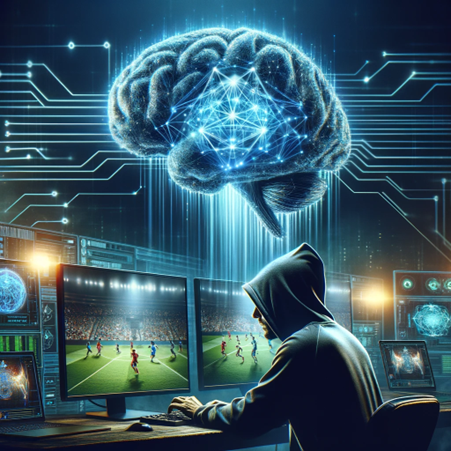Maximising artificial intelligence in the fight against sports piracy
 By Matt Stagg, media and entertainment innovation specialist.
By Matt Stagg, media and entertainment innovation specialist.
In the ever-evolving landscape of sports broadcasting, the spectre of piracy casts a long shadow, challenging the integrity of content distribution and posing significant hurdles for rights holders and broadcasters.
However, amidst this digital battleground, the potential of artificial intelligence (AI) to revolutionise the fight against sports piracy holds immense promise. While AI has already demonstrated remarkable capabilities in various domains, its application in combating piracy is still in its early stages. Yet, the possibilities it presents are groundbreaking, offering innovative solutions to protect sports content and uphold the rights of stakeholders.
One of the most compelling ways AI could transform the battle against sports piracy is through advanced content recognition and detection systems. Imagine algorithms capable of not only identifying unauthorised broadcasts or streams of sports events but also predicting potential instances of piracy before they occur. By analysing vast amounts of data, including historical piracy trends and online user behaviour, AI could anticipate emerging threats and empower rights holders to take proactive measures to mitigate them.
Pivotal role
Furthermore, AI-driven social media monitoring tools could play a pivotal role in detecting and addressing sports piracy on popular platforms. These tools could utilise sophisticated algorithms to scan text, images, and video content in real-time, flagging instances of piracy and enabling swift action to be taken against infringing parties. By leveraging natural language processing capabilities, rights holders could effectively monitor social media channels for unauthorised distribution of sports content, safeguarding their intellectual property rights.
Additionally, AI-powered watermarking and tracking technologies have the potential to revolutionise how sports content is protected and monitored across various channels. By embedding invisible watermarks or unique identifiers into sports broadcasts, AI could enable rights holders to track the dissemination of their content in real-time, regardless of where it is shared or distributed. This level of visibility would not only facilitate the detection of piracy but also provide valuable insights into consumer behaviour and content consumption patterns.
Moreover, predictive analytics capabilities could offer invaluable insights into the evolving landscape of sports piracy, enabling rights holders to stay one step ahead of infringers. By analysing vast amounts of data, including user demographics, viewing habits, and market trends, AI could identify potential piracy hotspots and emerging distribution channels. Armed with this foresight, rights holders could develop targeted strategies to combat piracy effectively and protect their valuable content.
And then there is the draw of AI-driven pricing models; these could turn the economics of sports broadcasting on its head in this aspect, making legitimate content more accessible and affordable to consumers. By leveraging AI’s ability to analyse consumer preferences and market dynamics, broadcasters could optimise pricing strategies to incentivise lawful consumption while minimising the appeal of pirated alternatives. This could create a more sustainable and equitable broadcasting ecosystem, benefiting both rights holders and consumers alike.
Harnessing the power
As AI continues to evolve, it’s essential to recognise that pirates could also harness its power to amplify their efforts in sports piracy. Just as legitimate stakeholders seek to leverage AI for detection and prevention, pirates could employ algorithms to develop more sophisticated methods of distributing unauthorized sports content. With AI-driven tools, pirates could evade detection, manipulate content, and exploit loopholes in existing anti-piracy measures, presenting a formidable challenge to rights holders and broadcasters.
In the looming battle of AI, it’s crucial to maintain a balance between technological innovation and human intervention. While AI can enhance efficiency and effectiveness in piracy prevention, human expertise remains indispensable in strategic decision-making, legal enforcement, and fostering innovation. By combining the strengths of AI and human intelligence, the sports industry can mount a more robust defence against piracy while creating new opportunities for job creation and advancement.
In the end, the fight against sports piracy is not merely about thwarting illegal activities but also about preserving the integrity of sports content, sustaining the livelihoods of athletes and creators, and safeguarding the interests of fans worldwide. By embracing a collaborative approach that harnesses the power of both AI and human ingenuity, the sports industry can hope to emerge victorious in this battle, ensuring a future where sports content is enjoyed lawfully, ethically, and sustainably.

